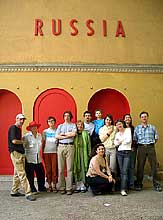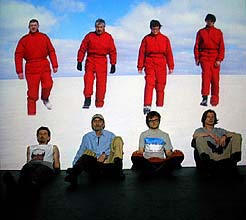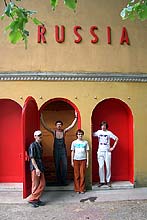"Too
long to escape"
Interactive slide installation. 51 Venice
Biennale, Russian pavilion, Gardini, Venice
 
 
The history of art is a history of a boundary.
There, on the futher side, stays a human artist - here, on this
side, staysa human viewer.
Or a human crowd.
The surface of a painting is a no man's land, where an encounter
might become possible.
When it becomes possible, the boundary will be destroyed.
However, then the Art will die.
Two pedestrians simultaneously take off from two points toward each
other at the speed of X.
One of them is artist.
The artist wishes to do away with the Art because he knows that
the Art is a golden cage, he has built for himself.
He believes that there is a human viewer moving toward him.
He believes that the viewer wishes to meet him as much as he does,
and that it will be possible to cross the border.
He believes that the New World will come and there will be no artist
or
viewer, no customer or commodity, and the lion shall lie down with
the lamb. However when the way-worn artist, approaches to the boundary,
which separates the art and the life, he will not see that sole
viewer toward whom he has taken off.
There will be an anormous and silent crowd.
It doesn't wish to cress the boundary, it doesn't wish to do away
with Art, it doesn t wish the New World to come.
It stares fixedly at him.
The artist makes another step.
Fire.
B. Mamonov
Russian Pavillion
The exhibition in the Russian pavilion reveals the dialectics of
interaction between the artist and his public. The authors of the
installations create the communicative space in such a way that
the works of art find their realization only with the participation
of the viewers. A work of art is a reference object, which necessitates
negotiations and implies the Other. These thoughts are very relevant
in Russia, where the contemporary art still remains a blind spot
on the map of culture.
Communication and miscommunication are the uppermost subject
in the creative work of the artists from Moscow, members of the
ESCAPE program. Blending the public and the private, they offer
viewers various modes of "implication": to look in the
privacies of artists' everyday life, to buy their paraphernalia
or pirate copies of works by famous Russian artists, to participate
in the ceremony of Invention of the Motherland. The artists establish
an alternative touring agency, where they act as guide-instructors.
Close communication produces involuntary scepsis and disillusionment.
Impossibility or unwillingness to listen and to understand each
other are reflected upon in a delicate video "Quartette",
where the image of execution of an opus by Beethoven is combined
with a sound-track by Shostakovich. The "Vertigo" installation
arranges the meeting of the artist and the viewers in a bunker,
specially built from rusty metal, the scene of general mutual
alienation seen by a viewer (who has spent quite a time in the
queue) raises pessimistic questions. Maybe, this metal-clad building
is a symbol of aloofness and self-sufficiency of the contemporary
art.
Interactive video installation "Too Long to Escape",
created specially for the Venice Biennale offers viewers an interactive
game with the artists, who move towards the public with the speed
proportional to the quantity of the viewers entering in the hall.
The attempt to describe the problem arithmetically: the more the
viewers, the faster the approach; reveals relativism and formalism
of mass strategies. Besides the irony about the wish to please
viewers, the artists raise the question of whether these interactive
performances are no more than a simulation of dialogism, which
hides passive solitude of the viewer. Evident reminiscences from
the Russian Vanguard (the composition of the scene takes inspiration
in Red Calvary by K. Malevich) develop the theme in historic perspective,
reminding of leftist experiments in mass production and consumption
of art.
Galina Myznikova and Sergey Provorov, artists from Nizhniy Novgorod,
who work with the topical concept of "public space"
don't consider the relationships with the public to be so dramatic.
They treat viewers as consumers of a specific info-visual product.
Their long-term project can be located somewhere between public
art and advertising, design and experimental cinema and TV. Unfamiliar
with alienation from the society, the artists try to remain within,
easily combining the positions of a consumer and a sober cool-headed
analyst, judging the situation from the outside. This flexible
approach inspires them to work over social projects, suggesting
innovative ways of communication. For example, in projects of
interactive icon-stands and cemeteries enable viewers to manually
(using mouse or touch pad) find their way to the transcendence
or to turn from a simple observer of an advertising action into
a participant in a mass performance. Voluntary dwelling in instable
and marginal areas, where usual cultural codes become invalid,
the artists begin to interact with the mass culture instead of
opposing to it. That's why they are constantly fascinated with
the possibilities of producing new objects, images and rites destined
to subsequent mass copying. However, this approach does not interfere
with critical perception of the reality and constant alarming
on seemingly safest things.
This is the case at the "Idiot wind" installation at
the Venice Biennale. Standing in an aero-acoustic space, the viewer
becomes the main character of this work of art, who should feel
the power of art with his own psycho-somatic senses. In the first
section of the pavilion one can easily touch and try to catch
the wind, but then he/she becomes strongly influenced by the increasing
power of windblasts. The force of physical action arouses complex
metaphysical feelings, and its visual minimalism suggests numerous
mythopoetic connotations of wind, air and elements
Liubov Saprykina
What's there to discuss with you?!
Like mythological Saturn the Art devours its children. It turns
prospering artists into abstract common-use signs, taking away
their individual traits and venial faults. There is not much to
discuss with a direction sign, which supports only one-way communication.
Rationalized gloria mundi fabrication processes don't tolerate
alchemic involuntariness. Their composition lacks miracle - including
the miracle of human communication.
Nowadays, in the age of video installations, digital animation,
new media and absolute interactivity, the miracle is substituted
by crafty technological juggler's delusions. They can provide
finest simulations of ethical and esthetic interaction between
the author and the viewer. However, these transient emotions are
soon forgotten in the open air outside exhibition halls. In the
reality, the contemporary art is nowadays much more distant from
the viewers than the conventional art making a cult of a god-like
creator.
The notion of "esthetics of participation", universally
popular for a decade already, was suggested as an operational
hypothesis by Nicola Burrio. This idea owes its longevity to the
existential drama, a sad endless story, engaging the artist and
the viewer against their will. The artists from the Russian pavilion
take another attempt to stage their impossible rendezvous and
to establish a desirable but unachievable contact.
Paradoxically enough, both projects employ "mechanical amusement
devices" to create the emotion. The replacement of "pure
lyrics" by astute machinery reflects sober pessimism of the
authors, who don't believe in successful experiments with transgression
of protected boundaries of the Art. The scenario of theatrical,
equally temporal and spatial interactive installations only confirms
the presentiment. On both storeys of the pavilion, the latent
mutual alienation of artists and viewers finally reveals itself
in an ultimately spectacular aerodynamic way.
Cyclonic air masses chuck viewers out of the last hall by Provorov
and Myznikova, while the members of the Escape group take off
in their flight to a show-covered far-away, as if coming butt
against an elastic invisible screen. This tragic final contrasts
with the cheerful beginning and the triumphant pace of the artists
moving towards viewers. Rain or shine, they'll never meet.
This is a paradox, but such a showy, cheerful and synchronized
(it is not even a duet (in the number of Russian projects), but
a full sextet (in the number of artists)) denial of any possibility
of communication, can't help but set thinking about certain merits
of discommunication. An artist takes a habit of solitude, but
as soon as he has to communicate with his viewer, the latter has
is inevitably infected with the artist's solipsism. The vanguard
has shifted artistic energy from the familiar surface of a painting
(relegated to zero of form by Malevich) to virgin 3D spaces of
revolutionary reality, however, its holistic and revivalist ambitions
were nourished by a reactionary subjective idealism, which takes
a reasoning (painting) individual for the center of the Universe
and the whole outer reality for the fruit of his mind. The radicals
from the Escape traverse a white field similar to a horizontal
virgin canvas, in aggressively red uniform, which can be closely
associated with "proto-closes" by Rodchenko and Stepanova.
Rodchenko and Stepanova were the most consistent experiment-makers
breeding the art and the life. This breeding had been conceived
to triumph the first but resulted in the victory of the second.
Socialist communal mass digested utopian pathos of the vanguard.
The slide-show by the Escape, where the increasing number of viewers
leads to an infamous end of artists, is somewhat of a dialectic
historical and esthetical allegory.
If socially engaged Escapists appeal to the brutal experience
of the historical vanguard, Sergey Provorov and Galina Myznikova,
successfully working in mass-culture, keep in mind a comfortable
atmosphere of consumerist havens: solaria, different "beauty
and health centers" and "one day resort clubs"
with their thermal procedures. The Idiot Wind installation is
a resort in-vitro, whose healing devices gradually get beyond
control bringing temperature and moisture conditions to their
natural unpredictability. Soft breeze generated by a fan suddenly
turns into a hurricane and the visitor of a beauty saloon finds
himself in the eye of a storm before any alert. The artist is
not a superhuman and all-mighty elementalist, he is the invisible
and uncontrollable Element itself, and he threatens fragile civilization.
The "windy" art makes viewers experience such deplorable
consequences as a messed-up hair or a skirt raised in public,
brutally trespassing cultural codes and thus, amplifying obvious
discommunication. After a visit to the Russian pavilion, the tourists
will have to get away to the hotel to arrange themselves - a beautiful
evening in Venice will be spoilt. This discomfort is an adequate
price for the happy thrill created by the installation. The effectiveness
of art is measured by its ability to break the usual communication,
its addiction to egoistic unsociality and inherent vanguard unculturedness.
While the Escape installation shows the crisis of this will, giving
an image of a non-interlocutory utopian artistic consciousness
beat up by the crowd, a minimalist and ascetic show by Provorov
and Myznikova embodies the triumph of will and somehow is a benefit
performance of the Art itself.
Of the art, that truly demands sacrifice. On the part of the
viewer, who experiences unpredicted tactile feelings, and on the
part of the artist, who is doomed to be tragically alone. At that
the process of decisive alienation concerns the authors themselves
- the "Escapists" acting as heroes and models in their
own installation can be easier associated with conceptualist red
letters marching across the blue sky background than with real
Aizenberg, Litvin, Mamonov and Morozova. The Art turns the artist
into a fake hieroglyph, an empty sign or a signified without a
signifier. This is a true Saturn, however, we owe to this amateur
of gastronomic incest for saturnalia - early predecessors of the
Venice biennale. These are the laws of the Art, revealed once
again in the works by the artists exhibited in the Russian pavilion.
Fedor Romer
- Keep a little to the right!
- Okay, but one of us jumped ahead!
- I can't catch up to you, you are moving too quickly!
- Hey, you are going the wrong way, you might leave the frame!
- I'm curious, if there is any life off the screen!
- You are confusing life with its feelings!
- You want to bring honesty, integrity, and fairness, but it's
all from your guilt and remorse.
- I agree, our mission is impossible!
- But it's not that far!
- We'll reach it, the place where we are going is close, but
that doesn't matter!
- Yet we went from the horizon! We departed a long time ago and
I lost count!
- The color is not visible from afar, and every person will appear
like a black spot!
- They must see us and go to us! So we'll get there in half the
time.
- If they will go toward us!
- But they might also go away from us, in the same direction,
and not look back!
- If we, they, and the horizon, move the same speed, we will
never meet each other!
- We are expecting too much from this meeting and it was right
to come empty-handed.
- But they are not coming closer because of an impenetrable hindrance!
A glass wall!
- They won't lose anything by waiting what they are waiting for!
- People can convince themselves about anything!
- Actually we can belief that there is nothing else but the mirror
wall in front of us.
- It's unthinkable that all this time we did not get anywhere!
- It is very good that we are going empty-handed!
- It is very good that we are not going empty-handed!
Valeriy Ayzenberg
|

